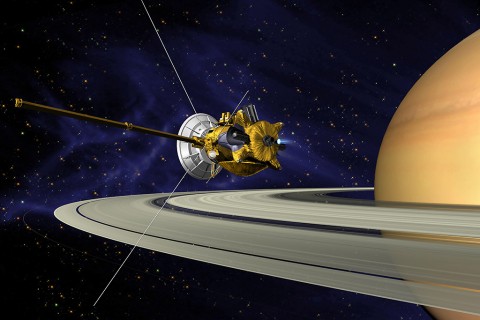Written by Preston Dyches
NASA’s Jet Propulsion Laboratory
 Pasadena, CA – NASA’s Cassini mission is entering its next chapter with an orbital choreography meant to tilt the spacecraft’s orbit out of Saturn’s ringplane.
Pasadena, CA – NASA’s Cassini mission is entering its next chapter with an orbital choreography meant to tilt the spacecraft’s orbit out of Saturn’s ringplane.
The second of five large propulsive maneuvers in this campaign took place on Saturday, January 23rd. Each maneuver in the series sets up a subsequent gravity-assist flyby of Saturn’s massive moon Titan, which reshapes the spacecraft’s orbit, sending it to increasingly higher inclination with respect to Saturn’s equator.

For comparison, the February 1st encounter with Titan that follows this engine firing will change the velocity by 2,539 feet per second (774 meters per second).
“Titan does all the heavy lifting,” said Earl Maize, Cassini project manager at NASA’s Jet Propulsion Laboratory, Pasadena, California. “Our job is to get the spacecraft to a precise altitude and latitude above Titan, at a particular time, and these large propulsive maneuvers are what keep us on target to do that.”
Cassini will not return again to an orbit near the plane of the rings. Engineers are slowly increasing the tilt of the spacecraft’s orbit with respect to Saturn’s equator to set up the mission’s final, dramatic year.
By late November, the spacecraft will be on a path that will carry it high above Saturn’s poles, approaching just outside the planet’s main rings — a period the mission team calls the “F-ring orbits.” After 20 F-ring orbits, Cassini will begin its Grand Finale event, in which the spacecraft will pass 22 times between the innermost rings and the planet before plunging into Saturn’s atmosphere to end its journey on September 15th, 2017.
Cassini has been in an equatorial orbit around Saturn since spring 2015, when it began its final campaign of close encounters with the planet’s large, icy moons. These flybys included the mission’s last close brushes with Hyperion, Dione and Enceladus.
The mission began its current push toward higher inclinations with a burn on December 30th that changed the spacecraft’s speed by 9.8 feet per second (3 meters per second) in preparation for a Titan flyby on January 15th. Another large main engine maneuver, designed to result in a velocity change of 26.08 feet per second (7.95 meters per second), is planned for March 25th, and sets up a Titan flyby on April 4th.
“We have an exciting year of Saturn science planned as we head for higher ground. And the views along the way should be spectacular,” said Linda Spilker, Cassini project scientist at JPL.
The Cassini-Huygens mission is a cooperative project of NASA, ESA (European Space Agency) and the Italian Space Agency. JPL manages the mission for NASA’s Science Mission Directorate in Washington.
For more information about Cassini, visit:
http://www.nasa.gov/cassini
http://saturn.jpl.nasa.gov



